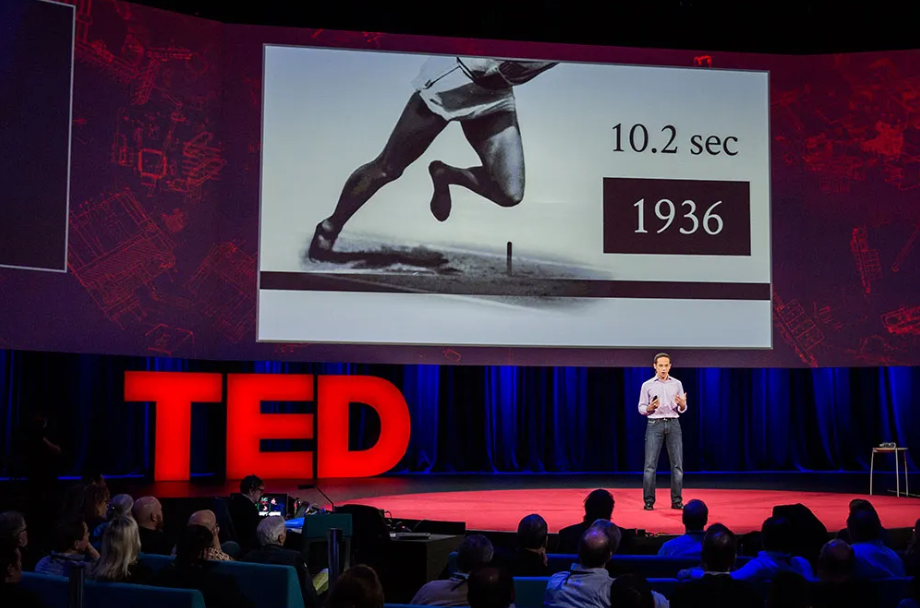18 February 2024
In the captivating world of TED Talks, these speakers offer a goldmine of presentation wisdom and inspiration. Plenty of lessons can be found in the hundreds of talks from all types of speakers across countries, disciplines, and industries. In this blog, we will learn more about the key approaches these presenters use that can elevate your presentation to a whole new level. As we explore the valuable lessons that TED Talks offer us, these strategies will help you forge a meaningful connection with the audience.
What we can learn from TED Talks
Focus on one central idea
Do not use your presentation as an opportunity to dump as much information on your audience as possible. Rather, use this time to focus on one topic and do it justice. The aim of your presentation should be to have the audience walk away with a central thesis that stays in their minds and hearts. Straying away from your main idea by trying to cover several topics at once will distract the audience and take attention away from your main points. So build your slides to serve one main message, where every point connects back to your thesis.
Start with your “why”
Calling back to Simon Sinek’s famous presenting style, many TED Talks borrow his technique of starting with your “why.” When you understand your own “why,” you can build a connection with your audience by compelling them to consider your core motivations for your presentation. But first, you need to ask yourself this question. Establishing your motives allows you to zero in on what your purpose is, what your goal is, and what your action plan is. Your “why” provides a direction to go forward with, allowing you to pursue it with authenticity and purpose.
Give your examples first before you explain your points
You can’t really have an audience get on board with your vision without painting them a vivid picture first, and the best way to do that is by providing examples. In other words, show, don’t tell. Share examples by telling stories and testimonials to provide background before explaining your points, as this technique naturally offers a hook for each section of your presentation. In many TED Talks, notice how many times the speaker uses a story as an example. You’ll also notice that it will take a while to reach their main topic. It might seem random, but it is done intentionally to draw in the listeners.
Build rapport
Building on our previous point, sharing stories also plays a large role in building rapport with the audience. Through them, you gain their trust and investment in your speech. By engaging with them through stories and humor, you capture their attention and build some understanding between each other, cultivating a relationship. Once you’re able to hit it off with members of your audience, you can communicate your message with impact. Hone in on this strategy by placing your most significant points towards the end of your presentation when the audience is most likely to remember it.
Speech pace isn’t that important
A lot of presenting advice out there encourages speakers to speak slowly to enunciate their words. We’re here to tell you that it doesn’t actually matter. Across different TED Talks, the speakers vary in their speaking styles, the most notable being their pace. In some of the most popular talks, the speaker speaks slowly, with purpose and sincerity, and in a manner that draws the audience in. However, other popular talks feature very energetic speakers who jump around in excitement and speak at a great speed. This means that the pace doesn’t play a big role the way you think it does. Whenever you present, it is your personality and passion that make an impact.
You don’t need to reinvent the wheel
In our fast-paced world of ideas and innovation, it’s easy to get caught up in the race to pursue groundbreaking ideas and concepts. However, if there’s anything we can learn from TED, it’s that original ideas don’t exist. And that’s not a bad thing. Many of the most impactful TED Talks are centered around familiar concepts that have been around for a long time. It is liberating to know that you don’t need to reinvent the wheel every time you want to share your knowledge or ideas with others.
What these examples tell us is that it’s not necessarily about having a groundbreaking idea but rather about how you approach and communicate these ideas, which is what makes a presentation successful. The power lies in a presenter’s ability to share familiar concepts in a fresh way to resonate with their audience. It’s about revamping how you present these ideas.
Minimalist design
Minimal design plays a large role in TED speeches, providing us with several examples to be inspired by. These speakers know that simple visuals allow for the message to shine through without being overshadowed. When creating presentation slides, embracing minimalism encourages you to remove any potential distractions and focus on your key ideas, thus fostering a closer connection with listeners. Minimalism as a principle extends far beyond TED Talks; it is a timeless and universal concept that will always guarantee an enhanced slide deck. So, remember, less is often more when showcasing your message.
As we’ve explored, TED Talks offers many examples to learn from. The techniques used by TED speakers are tried and true, sharing many valuable lessons to incorporate into your own presentations. From finding your “why” to building rapport, these strategies will ensure that you build a profound connection with your audience. So as you plan out your next presentation, integrate these methods to deliver a truly memorable speech.
Reference:







